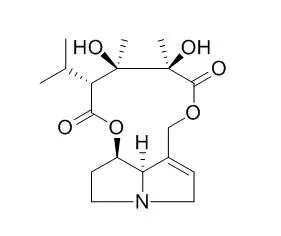| Description: |
Trichodesmine has greater lethality and neurotoxicity than monocrotaline, because of the two structural characteristics:(a) steric hindrance at position 14 of dehydroTrichodesmine results in greater resistance to hydrolysis, allowing more to be released from the liver and to be delivered to the brain;(b) the larger isopropyl substituent at position 14 of dehydroTrichodesmine renders the molecule more lipophilic, leading to greater penetration of the brain.
|
| In vitro: |
| Toxicol Appl Pharmacol. 1995 Aug;133(2):277-84. | | The comparative metabolism of the four pyrrolizidine alkaloids, seneciphylline, retrorsine, monocrotaline, and trichodesmine in the isolated, perfused rat liver.[Pubmed: 7645024] |
Despite their similarity in structure, pyrrolizidine alkaloids (PAs) vary in their LD50s and in the organs in which toxicity is expressed. We have examined whether there are differences in the metabolism of certain PAs that are associated with these quantitative and qualitative differences in toxicity.
METHODS AND RESULTS:
Isolated rat livers were perfused with one of four PAs (seneciphylline, retrorsine, monocrotaline, and Trichodesmine) at 0.5 mM for 1 hr, and the pyrrolic metabolites determined that were released into perfusate and bile or bound in the liver. The proportion of the PA removed by the liver varied from 93% for retrorsine to 55% for Trichodesmine. However, Trichodesmine-perfused livers released the greatest amount of the dehydroalkaloid into the perfusate. These reactive pyrrolic metabolites appear to be largely responsible for the toxicity of PAs. Over the course of a 1-hr perfusion, dehydroalkaloid release varied fourfold among the PAs examined. Seneciphylline and retrorsine significantly increased bile flow. Highest concentrations of PAs in bile were achieved at 30-40 min perfusion. Conversion of dehydroalkaloid to the conjugate 7-glutathionyl-6,7-dihydro-1-hydroxymethyl-5H-pyrrolizine (GSDHP) is a detoxification reaction. GSDHP release into bile varied from 80 nmol/g liver for Trichodesmine to 880 nmol/g for retrorsine. Release of the less toxic hydrolytic product of dehydroalkaloids, 6,7-dihydro-7-hydroxy-1-hydroxymethyl-5H-pyrrolizine, was also determined. Bound pyrroles in liver are probably an indication of heptatoxicity. At the end of perfusion these varied from 55 nmol/g for monocrotaline to 195 nmol/g for retrorsine. The chemical form of the bound pyrroles is a 7-thioether conjugate of 6,7-dihydro-1-hydroxymethyl-5H-pyrrolizine. No 7,9-dithio conjugate was detected, indicating that only monoalkylation has been found.
CONCLUSIONS:
These differences in metabolic pattern reflect differences in reactivity of the initially formed dehydroalkaloid and can account for the toxicological differences between the parent PAs. |
|
| In vivo: |
| Neurochem Res. 1996 Feb;21(2):141-6. | | Physicochemical and metabolic basis for the differing neurotoxicity of the pyrrolizidine alkaloids, trichodesmine and monocrotaline.[Pubmed: 9182239 ] |
METHODS AND RESULTS:
Monocrotaline and Trichodesmine are structurally closely related pyrrolizidine alkaloids (PAs) exhibiting different extrahepatic toxicities, Trichodesmine being neurotoxic (LD(50) 57 mu mol/kg) and monocrotaline pneumotoxic (LD(50) 335 mu mol/kg). More dehydroTrichodesmine (468 nmol/g liver) than dehydromonocrotaline (116 nmol/g liver) was released from liver into perfusate on perfusion for 1 hr with 0.5 mM of the parent PA. DehydroTrichodesmine had a significantly longer aqueous half-life (5.4 sec) than that of dehydromonocrotaline (3.4 sec). In vivo, significantly higher levels of bound pyrroles were found in the brain 18 hr after injection of Trichodesmine (25 mg/kg; i.p.) than were seen following either an equal dose (25 mg/kg; i.p.) or an equitoxic dose (90 mg/kg; i.p.) of monocrotaline. Trichodesmine had a higher partition coefficient than monocrotaline for both chloroform and heptane, indicating its greater lipophilicity. The pK(a) of Trichodesmine (7.07) was only slightly higher than that of monocrotaline (pK(a¿ 6.83), suggesting that a difference in degree of ionization was not a major factor affecting the relative ability of the dehydroalkaloids to cross the blood-brain barrier.
CONCLUSIONS:
We conclude that the greater lethality and neurotoxicity of Trichodesmine compared to monocrotaline is due to two structural characteristics: (i) steric hindrance at position 14 of dehydroTrichodesmine results in greater resistance to hydrolysis, allowing more to be released from the liver and to be delivered to the brain; (ii) the larger isopropyl substituent at position 14 of dehydroTrichodesmine renders the molecule more lipophilic, leading to greater penetration of the brain. | | Toxicon. 1995 May;33(5):627-34. | | The effect of the pyrrolizidine alkaloids, monocrotaline and trichodesmine, on tissue pyrrole binding and glutathione metabolism in the rat.[Pubmed: 7660367] |
METHODS AND RESULTS:
One day after in vivo administration of equitoxic doses of the hepatotoxic and pneumotoxic pyrrolizidine alkaloid, monocrotaline (65 mg/kg, i. p.) or the related hepatotoxic and neurotoxic alkaloid Trichodesmine (15 mg/kg, i. p.) hepatic GSH levels are increased by more than 50%. These doses of alkaloids represent 60% of the LD50 values. Accompanying these changes in GSH levels is an increase in the overall rate of GSH synthesis in supernatants of alkaloid-exposed livers. The ability of the rat to metabolize the two alkaloids was shown by the appearance of tissuebound pyrrolic metabolites of pyrrolizidines in various organs.
CONCLUSIONS:
The levels of these metabolites appear to correlate with organ toxicity. For the hepatic and pneumotoxic alkaloid, monocrotaline, higher levels are found in liver (17 nmoles/g tissue) and lung (10 nmoles/g) than for Trichodesmine (7 nmoles/g and 8 nmoles/g, respectively). For the neurotoxic alkaloid, Trichodesmine, higher levels are found in brain (3.8 nmoles/g tissue) than for monocrotaline (1.7 nmoles/g tissue). |
|






 Cell. 2018 Jan 11;172(1-2):249-261.e12. doi: 10.1016/j.cell.2017.12.019.IF=36.216(2019)
Cell. 2018 Jan 11;172(1-2):249-261.e12. doi: 10.1016/j.cell.2017.12.019.IF=36.216(2019) Cell Metab. 2020 Mar 3;31(3):534-548.e5. doi: 10.1016/j.cmet.2020.01.002.IF=22.415(2019)
Cell Metab. 2020 Mar 3;31(3):534-548.e5. doi: 10.1016/j.cmet.2020.01.002.IF=22.415(2019) Mol Cell. 2017 Nov 16;68(4):673-685.e6. doi: 10.1016/j.molcel.2017.10.022.IF=14.548(2019)
Mol Cell. 2017 Nov 16;68(4):673-685.e6. doi: 10.1016/j.molcel.2017.10.022.IF=14.548(2019)